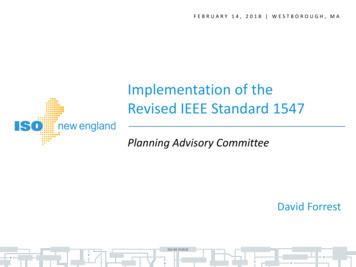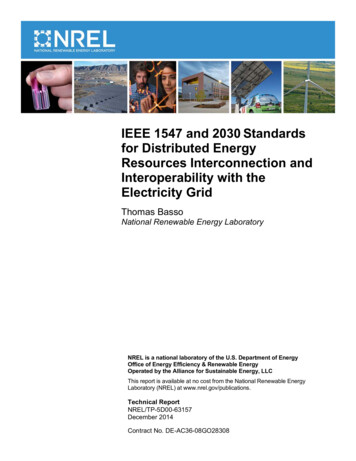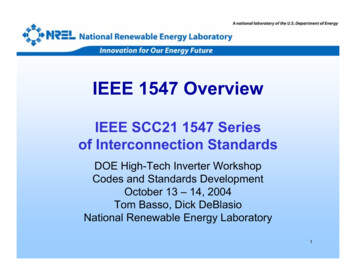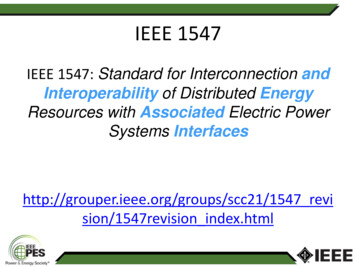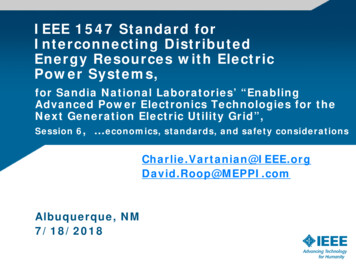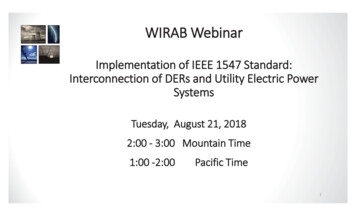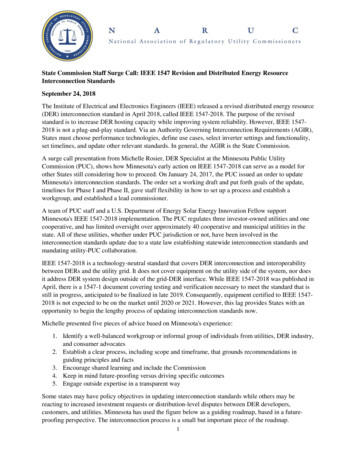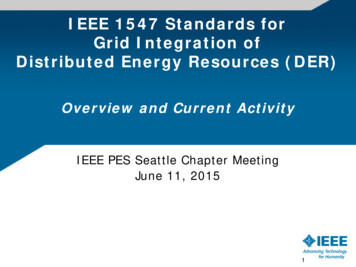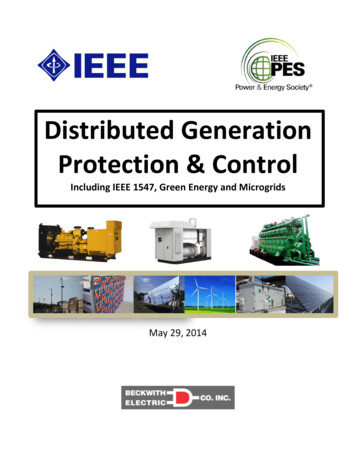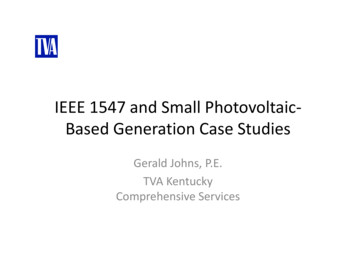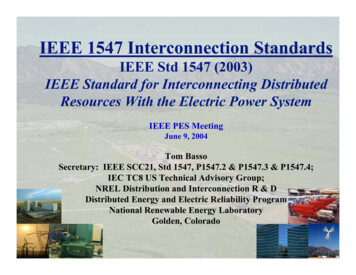
Transcription
IEEE 1547 Interconnection StandardsIEEE Std 1547 (2003)IEEE Standard for Interconnecting DistributedResources With the Electric Power SystemIEEE PES MeetingJune 9, 2004Tom BassoSecretary: IEEE SCC21, Std 1547, P1547.2 & P1547.3 & P1547.4;IEC TC8 US Technical Advisory Group;NREL Distribution and Interconnection R & DDistributed Energy and Electric Reliability ProgramNational Renewable Energy LaboratoryGolden, Colorado1
Outline¾ Background: Distributed Energy Resources (DER or DR)¾ Introduction: Standards & Technology Development.¾ IEEE SCC21: Standards Coordinating Committee 21¾ IEEE 1547 Series of Interconnection Stds- ANSI/IEEE Std 1547 (2003): interconnection system & interconnection testrequirements for interconnecting DR with Electric Power Systems (EPS)- P1547.1 standard for interconnection test procedures- P1547.2 guide to 1547 standard- P1547.3 guide for information exchange for DR interconnected with EPS- P1547.4 guide for DR island systems¾ Moving Forward2
Summary Remarks Standards Are Being Developed and Validated In aTimely, Ongoing and Cohesive Manner. Standards Are Promoting Advanced TechnologyDevelopment That Is Successfully Incorporating NextGeneration Standardized Functionalities. Standardization Is Enhancing Systems Integration ofSound Distributed Energy Resources With The Grid ThatAre Contributing To Modernizing Our Electric Infrastructure.3
Transmission andDistribution SystemBulk sion SystemCommunications – Information Flow, Data Management,Monitor & erationsensorsCombined Heat& Power4
What is a DER ?DER* is defined as a small-scale electricgenerator located next to and connected to theload being served either with or without anelectric grid interconnection* sometimes referred to as a DG (distributed generator)5
DER Technology PortfolioExamplesReciprocating EnginesFuel CellsAdvanced TurbinesPhotovoltaicsWindThermally ActivatedTechnologiesMicroturbines6
DER Grid InterconnectionPotential Consumer BenefitsPotential Supplier Benefits Clean energy Reduced electric line loss Lower cost electricity Reduced T&D congestion Reduced price volatility Grid investment deferment andimproved grid asset utilization Greater reliability and powerquality Energy and load management Combined Heat and Power Improved grid reliability Ancillary services, e.g., voltagesupport and stability, VARs,contingency reserves, andblack start capabilityÎGreater flexibility and energy ethesebenefitsbenefits7
Standards & Technology StandardizationStandards Development and Validation¾ Safeguards against hazards¾ Fostering quality design and manufacture¾ Increased competitiveness in industry¾ Create and expand markets¾ Facilitate Trade and Commerce¾ Assurance is provided when products meet qualitystandards, then users need not be concerned withfurther testing or evaluation of the product8
IEEE Interconnection Standards American National Standard IEEE1547 Published 2003 Developed by IEEE Standards Coordinating Committee 21(IEEE SCC21) SCC21 developing 1547 Series of Interconnection Standards SCC 21 responsible for standards development in areas of––––Fuel cellsPhotovoltaicsDispersed generationEnergy storage 400 SCC21 work group members (all work groups)9
IEEE Standards Coordinating Committee 21(SCC21) ‘Fuel Cells, Photovoltaics, DispersedGeneration, and Energy Storage’Oversees the development of standards in the areas ofFuel Cells, Photovoltaics, Dispersed Generation, andEnergy Storage, and coordinates efforts in these fieldsamong the various IEEE Societies and other affectedorganizations to ensure that all standards areconsistent and properly reflect the views of allapplicable disciplines.IEEE SCC21reviews all proposed IEEE standards inthese fields before their submission to the IEEE-SAStandards Board for approval and coordinatessubmission to other organizations.10
IEEE SCC21 Approach National consensus standards established via industry drivenpartnerships under IEEE SCC21; SCC21 also provides liaisonactivities. Harmonization of national and international standards, codes,and certification/laboratory accreditation- International Electro-technical Commission (IEC) dual logoarrangement for IEC to adopt IEEE standards for electronics,telecom, and power generation.- IEC Technical Committee 8 (electrical systems) scope andpurpose was reformulated spring 2003.11
IEC TC8 System Aspects for Electrical Energy Supply(International Electro-technical Commission Technical Committee 8)TC8 Scope – To prepare the necessary standards framework and co-ordinate thedevelopment, in co-operation with other TC/SCs, of the international standardsneeded to facilitate the functioning of electricity supply systems in open markets.(former scope – standardize voltages, current ratings, and frequencies).TC8 Focus Areas – electrical system adequacy (availability of supply), connectionpractices, operations, network responsibility, Measurement and monitoring, dataexchange, communication, security, terminology.Interface with other TC’ s ( 1,9,13,17,22,28,57,64,65,73,77,82,88,95,99,105), andSC17C, SC77, ACENELEC, CIGRE, CIRED EURELECTRIC, IEEE, IEEJ, NERC,ORGAIM, NAESB, etc.USNC–TC8 TAG (Technical Advisory Group) Administrator - NREL designated asTAG Administrator for the USNC TAG for IEC/TC-8USTAG TC8 Membership:established Feb 2004; Technical Advisors T. Basso and J. Koepfinger12
American National StandardANSI/IEEE 1547 StdÆ IEEE Std 1547 (2003) published summer 2003 Å Affirmative IEEE Ballot February 2003- Voting Membership¾ 230 members (31% general interest, 4% government,30% producer, 35% user)¾ 91% affirmatives- 444 Work Group and Ballot Group Members at time of ballot Approved by IEEE Standards Board June 12, 2003 American National Standard designation(ANSI/IEEE Std 1547 - October 20, 2003)13
IEEE SCC21 1547 Standard &series of interconnection projectsIEEE Std 1547TM (2003) Standard for InterconnectingDistributed Resources with Electric Power SystemsGuide for ImpactsGuide for NetworksP1547.4 Draft Guide forP1547.3Draft Guide for Monitoring,Information Exchange andControl of DRInterconnected with EPSP1547.2Draft ApplicationGuide for IEEEP1547 DraftStandard forInterconnectingDistributedResources withElectric PowerSystemsGuideForInterconnectionSystem CertificationDesign, Operation, andIntegration of DistributedResource Island Systems withElectric Power SystemsDP Specifications and Performance(includes modeling)P1547.1Draft Standard forConformance TestProcedures forEquipmentInterconnectingDistributedResources withElectric PowerSystems14
IEEE 1547 Interconnection Standard & ProjectsTitleScope & PurposeIEEE Std 1547 (2003)Standard forInterconnectingDistributed Resourceswith Electric PowerSystems(published June 2003) This Standard establishes criteria and requirementsfor interconnection of distributed resources (DR) withelectric power systems (EPS). This document provides a uniform standard forinterconnection of distributed resources with electricpower systems. It provides requirements relevant to theperformance, operation, testing, safety considerations,and maintenance of the interconnection.P1547.1 Draft Standardfor Conformance TestProcedures forEquipmentInterconnectingDistributed Resourceswith Electric PowerSystems This Standard specifies the type, production, andcommissioning tests that shall be performed todemonstrate that interconnection functions andequipment of a distributed resource (DR) conform toIEEE Std 1547. Interconnection equipment that connects distributedresources (DR) to an electric power system (EPS) mustmeet the requirements specified in IEEE StandardP1547. Standardized test procedures are necessary toestablish and verify compliance with thoserequirements. These test procedures must provide bothrepeatable results, independent of test location, andflexibility to accommodate a variety of DR technologies. 15TM
IEEE 1547 Interconnection ProjectsTitleScope and PurposeP1547.2 DraftApplication Guidefor IEEE Standard1547 forInterconnectingDistributedResources withElectric PowerSystems This Guide provides technical background and application detailsP1547.3: DraftGuide forMonitoring,InformationExchange andControl ofDistributedResourcesInterconnectedwith Electric PowerSystems This document provides guidelines for monitoring, informationto support the understanding of IEEE 1547 Standard forInterconnecting Distributed Resources with Electric Power Systems. This document facilitates the use of IEEE 1547 by characterizingthe various forms of distributed resource technologies and theassociated interconnection issues. Additionally, the backgroundand rationale of the technical requirements are discussed in termsof the operation of the distributed resource interconnection with theelectric power system. Presented in the document are technicaldescriptions and schematics, applications guidance andinterconnection examples to enhance the use of IEEE 1547.exchange, and control for distributed resources (DR) interconnectedwith electric power systems (EPS). This document facilitates the interoperability of one or moredistributed resources interconnected with electric power systems. Itdescribes functionality, parameters and methodologies formonitoring, information exchange and control for the interconnecteddistributed resources with, or associated with, electric powersystems. Distributed resources include systems in the areas of fuelcells, photovoltaics, wind turbines, microturbines, other distributedgenerators, and, distributed energy storage systems.16
IEEE 1547 Interconnection ProjectsTitleP1547.4 DraftGuide for Design,Operation, andIntegration ofDistributedResource IslandSystems withElectric PowerSystemsScope and Purpose This document provides alternative approaches and goodpractices for the design, operation, and integration ofdistributed resource (DR) island systems with electric powersystems (EPS). This includes the ability to separate fromand reconnect to part of the area EPS while providing powerto the islanded local EPSs. This guide includes thedistributed resources, interconnection systems, andparticipating electric power systems. This guide is intended to be used by EPS designers,operators, system integrators, and equipmentmanufacturers. The document is intended to provide anintroduction, overview and address engineering concerns ofDR island systems. It is relevant to the design, operation,and integration of DR island systems. Implementation of thisguide will expand the benefits of using DR by targetingimproved electric power system reliability and build upon theinterconnection requirements of IEEE 1547.17
Std 1547: Interconnection Is The temAreaElectricPowerSystem(EPS)Interconnection system requirements and specificationsand test requirements and specifications18
P1547.1 Std DevelopmentIEEE P1547.1 test standard for 1547 -- plan ballot ready draft 2004; thisstandard specifies the type, production, and commissioning tests that shall beperformed to demonstrate that interconnection functions and equipment of adistributed resource (DR) conform to IEEE Std 1547.Interconnection System (ICS)DistributedResource(DR)(Internal Combustion,Photovoltaics, Wind, Fuel Cell,Turbine, Storage, etc.)EnergyConversion(Inverter ,Converter)System Control(Output Levels, Start/Stop, etc.)Electrical Protection(abnormal protection)Generator(Induction,Synchronous)Area EPSorLocal EPSSteady-State Control(V, I, VAR, pf)Figure 1. Definition of the installation and its content. (P1547.1 Draft 4 4/04)19
P1547.2 Draft DevelopmentIEEE P1547.2 application guide to 1547 is being developed; “guide” offersalternate approaches – e.g., practical applications guidance, tips,techniques and rules of thumb for applying IEEE 1547 to specificinterconnection situations on specific utility distribution feeders. Industryidentified this as critically important practical companion to 1547.Example of an alternateapproach to 1547 requirements.(Graphic From "UniversalInterconnection Technology(UIT) Workshop Proceedings”NREL/BK-560-32865.)20
P1547.3 Draft DevelopmentP1547.3 guide to information exchange, monitoring and control for DR is beingdeveloped; “guide” offers alternate approaches – e.g., power industrycommunications guidance for specific cases of DR interconnection situations.DR AggregatorPoint of CommonCoupling (PCC)Distr. Sys. OperatorPoint of DRConnectionDR OperatorDR MaintainerPoint of LoadConnection r of PackagingLegendInterconnection Info Path (in scope)Local Info Path (out of scope)Electric Path (out of scope)Local EPSFigure 1: Information Exchange ReferenceDiagram (P1547.3 Draft 11/03)21
P1547.4 Guide for Design, Operation, and Integrationof DR Island Systems with Electric Power Systems-- Work Group Inaugural Meeting Aug 5-6, 2004 -Background: Operating Concepts for theDistribution System Radial Distribution System: The most commontype of connection between utility and load. Poweronly flows from utility to load. Microgrid or Intentional Island: Aggregation ofloads and sources capable of operating either inparallel with or to end users. Depending onconfiguration, power flows only within microgrid orcan export power to utility.Independent from a larger electric grid, whileproviding continuous power. Networked Distribution System w/ 2-way powerflow: Distribution in which the secondaries of thedistribution transformers are connected in a grid,typically energized at the customers’ utilizationvoltage, to serve multiple loads.UtilLoadGenUtilLoadGenUtilLoad22
IEEE Std 1547 INITIONS4.0INTERCONNECTION TECHNICALSPECIFICATIONS AND REQUIREMENTS5.0INTERCONNECTION TEST SPECIFICATIONSAND REQUIREMENTSAnnex A : Bibliography23
IEEE 1547 Table of ContentsINTRODUCTION1.0 OVERVIEW1.11.21.3ScopePurpose – Uniform standardrequirementsLimitations – 10 MVA or less2.0 REFERENCES3.0 DEFINITIONS24
A Technical Standard –Functional Requirements ForIEEE 1547IS: the interconnection itselfthe interconnection test Technology neutral, e.g., does not specify anyparticular equipment nor equipment type A single (whole) document of mandatory,uniform, universal, requirements Should be sufficient for most installations a design handbookIEEE 1547Is NOT: an application guide an interconnectionagreement prescriptive, e.g., does notaddress DR self-protection, norplanning, designing, operating,or maintaining the Area EPS.25
IEEE 1547 Interconnection26
IEEE 1547 Interconnection27
IEEE 1547 Interconnection Definitions Distributed generator (DG) –electric generation facilities connected to anArea EPS through a PCC; a subset of DR.Distributed resources (DR) – sources of electric power that are not directlyconnected to a bulk power transmission system. DR includes bothgenerator and energy storage technologies.Electric power system (EPS) – facilities that deliver power to a load.Area EPS – an EPS that serves local EPSs.Local EPS – an EPS entirely within a single premises or a group ofpremises.Interconnection – the result of the process of adding a DR unit to an areaEPSInterconnection equipment – individual or multiple devices used in aninterconnection systemInterconnection system – the collection of all interconnection equipment,taken as a group, used to interconnect a DR unit(s) to an area EPSPoint of common coupling (PCC) – the point where a local EPS isconnected to the Area EPS.Pont of DR connection – the point where a DR unit is electrically28connected in an EPS.
1547 Interconnection TermsArea Electric Power System (EPS)PCCPoint of CommonCoupling (PCC)Point of DRConnectionLoadLocal EPS 1DR unitLocal EPS 2PCCPoint of DRConnectionDR unitLoadLocal EPS 3Note: There can be any number of Local EPSs.29
Std 1547: Interconnection Is The temAreaElectricPowerSystem(EPS)30
4.0 INTERCONNECTION TECHNICALSPECIFICATIONS AND REQUIREMENTS4.1 General Requirements– Voltage Regulation– Integration with AreaEPS Grounding– Synchronization– DR on Secondary Gridand Spot Networks– Inadvertent Energizingof the Area EPS– Monitoring Provisions– Isolation Device– Interconnect Integrity31
4.0 Interconnection Technical Specifications and Requirements (cont’d)4.2 Response to Area EPS AbnormalConditionsArea EPS Faults– AREA EPS ReclosingCoordination– Voltage–– Frequency– Loss ofSynchronism– Reconnection to AreaEPS32
4.0 Interconnection Technical Specifications and Requirements (concluded)4.3 Power QualityLimitation of DC Injection– Limitation of Voltage Flicker Induced bythe DR– Harmonics–4.4 IslandingUnintentional Islanding– Intentional Islanding–33
5.0 INTERCONNECTION TESTSPECIFICATIONS AND REQUIREMENTS5.1 Design Test– Abnormal voltageand frequency– Synchronization– Interconnectionintegrity– Unintentional islanding– Limitation of DCinjection– Harmonics34
5.0 INTERCONNECTION TEST SPECIFICATIONS AND REQUIREMENTS(cont’d)5.2 Production Tests– Meet requirements of: response to abnormal voltage andfrequency synchronization may be performed at the factory or attime of commissioning5.3 Interconnection Installation Evaluation–––––Grounding Integration with area EPSIsolation DeviceMonitoring provisionsArea EPS faultsArea EPS reclosing coordination35
5.0 INTERCONNECTION TEST SPECIFICATIONS AND REQUIREMENTS(concluded)5.4 Commissioning Tests Visual InspectionOperability test on the isolation deviceUnintentional islanding functionality testCease to energize functionality test5.5 Periodic Interconnection Tests All interconnection-related protectivefunctions and associated batteriesAnnex A. Bibliography36
Application of 1547 (e.g, P1547.2) “Prime mover” traditionally performs fuel/primary-inputenergy conversion, e.g., recip engine, fuel cell, PV panelPrime mover characteristics have had limited interactioneffects on utility grid; they drive the electric generators:(synchronous, induction, or inverter–based). DG-grid interface is via “power conversion” devices and,relaying and switching protective devices/schemes.Power conversion characteristics largely contribute to DGgrid interaction effects; relaying, switching and protectiondevices/schemes largely contribute to DG-gridcoordination/operation interactions, Equipment technologies/approaches often combine abovedifferentiations of technical functionalities.Std 1547 functional technical requirements remain valid.37
E.g., Interconnection System Functional Block DiagramAC LoadsInterconnection SystemPowerConversionDERcontrolPower FlowCommunicationsLocal rSwitch orParallelingSwitchgearDispatchand controlMeterDERElectricGeneratorPC oinou tpl ofin CogmmonPowerDistribution(within dot-dash lines)DER(primemovers,energystorage))DC LoadsArea EPSProtectiveRelayingArea EPSPowerSystem(grid)The interconnection system (within the dotted line) is designed to handle the power betweenand serve as the communication and control gateway among the DER, the Area EPS and thecustomer loads. Workshops with industry provided a forum for furthering this activity andseveral manufacturers are working on developing and validating standardized, advanced,universal interconnection technologies [NREL/SR-560-32459].38
Synchronous Machines Synchronous DG similar to large utility generation Runs at a constant speed in synch with grid Subject to dynamic angle swings followingdisturbances– Can go unstable, pull out of synch for long faultor weak system connection Provides substantial short-circuit currentcontribution e.g., 5x - 6x ratingMost larger DERs today useconventional synchronousmachine technology39
Induction MachinesPOWER Similar to induction motor, turned faster thansynchronous speed (7200rpm / number of poles) Variable speed operation, over a limited range Requires a source of reactive powerPOWERINMOTOR0TYPICAL INDUCTIONGENERATOROPERATING POINTPOWEROUTGENERATORSPEED40
System Commutated InverterC DCSourceABCAB Requires system with external source– short-circuit strength– reactive power demand Sensitive to voltage dips and glitches Produces substantial current harmonics– square-wave-like current– often needs harmonic filters Low cost, low loss41
Voltage Source Inverter DCSource1-ph ac0 60120180Degrees240Uses pulse-width modulation1-ph or 3-phCan operate isolatedCan produce or consume reactive powerLower total harmonic distortion– at higher frequency, easier to filter– distortion depends on design300360CurrentInverter Voltage42
Comparison of “Converters”Synchronous InductionLine-Comm.VSIShort CircuitCurrent5-6 x rated,indefinitely5-6 x ratedfew cyclesNo load currentReactivePowerSupply orabsorbAbsorbAbsorbSupply orabsorbStand-aloneoperationYesOnce started,with VARsNoYes (controlmode shift)RequiressynchingYes, allSignificant,need filtersModerate, athigh freq.43
Application of 1547: DR-Grid Interconnection Short circuit contributionProtection coordinationVoltage regulationUnintentional islandingGrounding and overvoltagesNetwork issues--------- ------------------ ------------------Interconnection issues are real and resolvable:e.g., specific to: equipment, design, location,application, etc.44
Distribution Protection/Coordination Philosophies vary from utility to utility– Fuse Saving Schemes– Fuse Blowing Schemes– Instantaneous Reclose– Delayed Reclose No “Absolute” Solutions Recognize the Potential Misapplication45
Nuisance Fuse Operations Increased fault current blowsfuse before breaker opensDG current continues afterbreaker opens Fuse blows for main feederfaultDG46
DG & System Protection Traditional “radial” thinking Fault current magnitudes Fault current directions Fuses Reclosers47
Recloser and Line Fuse LocatedDown-line from DGIUSDGWithout DG:IF IUS IRWith DG:IF IUS IDGIDGIRF1SXIF 1470 AIF 1825 AandIR IFbutIR IUSIF phase-to-ground without DGIF phase-to-ground with DG48
Current in Amperes : x 1 at 12.5 kV.1000100Fuse Minimum MeltCurve10dS i iT1Recloser Fast Curve0.1IF without DG0.010.5110IF with DG100100010000T IME CURRENT CHARACT ERIST IC CURVESBY:PLOT T ING VOLT AGE:12.5 kVNO:DAT E:Time-current curves of recloser and fuse.49
Voltage Regulation Issuesw/o DGRange Awith DGDGRange AVRDG50
Moving Forward:Some Key 1547 Standards Issues (Research Activities) Develop interconnection technology (hardware) Address field testing vs. type testing Interconnection equipment certification Evaluate secondary grid and spot networks Develop grid/DG monitoring and control Understand voltage regulation/stability Address grounding/faults Establish basis for DG penetration/aggregation Develop islanding methods and requirements51
Moving Forward: Grid Modernization & 1547 ActivitiesValidation of, and Research on Integration of DR withAdvanced Distribution Operating Concepts: IEEE 1547 covers Unintentional Islanding, Intentional Islanding,Secondary Networks, and Spot Networks. The current version of IEEE 1547 minimizes the utilization ofdistributed resources in the event of system disturbances. Research on the system integration of DR with all types ofdistribution operational concepts is necessary to revise IEEE 1547 tomaximize the use of DR and realize the potential operational benefitsat the transmission and distribution level. E.g., P1547.4 Guide for DR Island Systems -- Work Groupinaugural meeting August 5 – 6, 2004.52
Distributed sFuel CellElectric PowerSystemsUtilityGrid Power ConversionPV Power Conditioning (PQ)Inverter Protection DER and Load ControlMicroturbineWind Ancillary ServicesEnergyStorageUtility Grid SimulatorMicro GridsLoads CommunicationsLocal Loads MeteringLoad SimulatorsSwitchgear, Relays,& Controls53Generator
Closing Remarks¾ Industry driven partnerships a success for 1547stakeholders.¾DOE and NREL support -- facilitating and leading IEEEindustry driven efforts.¾ IEEE 1547 American National Standard Published(order at 800-678-4333, or http://shop.ieee.org/store/ search 1547)¾1547 Series of Standards DevelopmentNext meeting August 3-6, 2004- P1547.1 standard for interconnection test procedures- P1547.2 guide to 1547 standard- P1547.3 guide for information exchange for DRinterconnected with EPS- P1547.4 guide for DR island systems54
Contact & Resource InformationNational Renewable Energy Laboratory1617 Cole Blvd. MS1614,Golden, CO 80401-3393 Tom BassoPhone 303-275-3753 – Email thomas basso@nrel.govBen Kroposki Phone 303-275-2979 – Email ben kroposki@nrel.govDick DeBlasio Email deblasid@tcplink.nrel.govNREL publications http://www.nrel.gov/publications orhttp://www.osti.gov/bridge (for help Amy Vaughn@nrel.gov)IEEE 1547 Standards Development IEEE SCC21 http://grouper.ieee.org/groups/scc21/dr shared/IEEE Std 1547 (2003) Standard for Interconnecting Distributed Resources WithElectric Power Systems http://standards.ieee.org/55
Resource Information:Basso, T.S. and DeBlasio, R. "IEEE P1547 Series of Standards forInterconnection: Preprint for IEEE Power Engineering SocietyTransmission and Distribution 2003 Conference and Exhibition"NREL/CP-560-34003. Golden, CO: NREL, May 2003.Basso T.S. and DeBlasio, R. “IEEE 1547 Series of Standards:Interconnection Issues.” NREL Report No. 34882. September 2003.Kroposki, B., Basso, T. and DeBlasio, R. “Interconnection Testing ofDistributed Resources” Preprint for 2004 PES General Meeting, June2004, NREL/CP-560-35569. Golden, CO: NREL.NREL/SR-560-32459 Distributed Energy Resources InterconnectionSystems: Technology Review and ResearchNREL/BK-560-32865 Universal Interconnection Technology WorkshopProceedings56
IEEE 1547 Interconnection Standards IEEE Std 1547 (2003) IEEE Standard for Interconnecting Distributed Resources With the Electric Power System IEEE PES Meeting June 9, 2004 Tom Basso Secretary: IEEE SCC21, Std 1547, P1547.2 & P1547.3 & P1547.4; IEC TC8 US Technical Adviso
